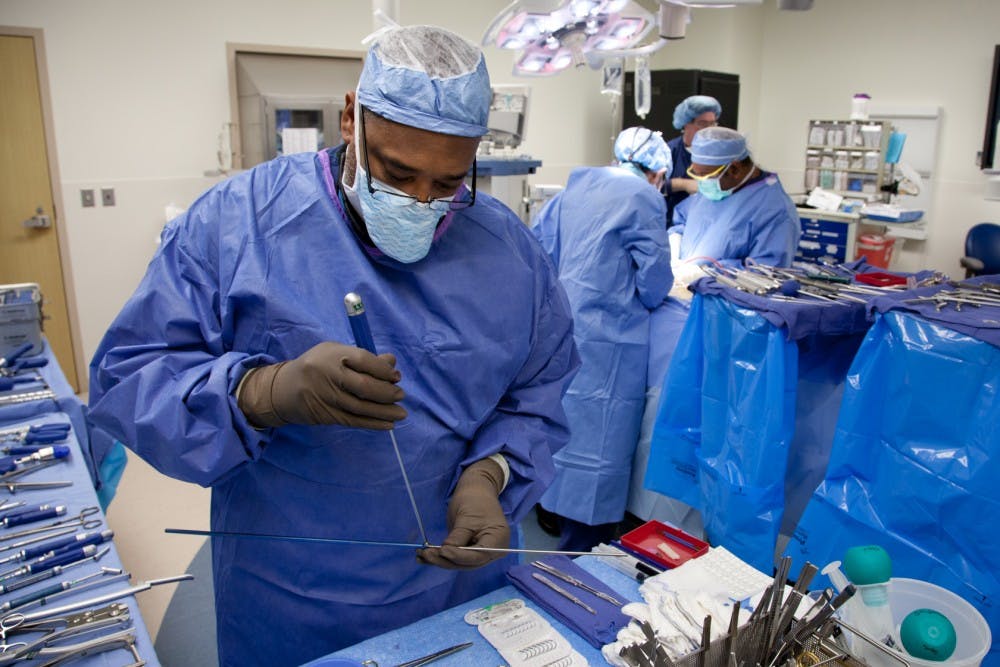ASU patent law students have serendipitously found themselves working at the forefront of medical discovery thanks to the establishment of a grant by an Arizona patent lawyer to help Barrow Neurological Institute residents develop their innovations.
Steven Lisa, a patent lawyer and ASU alumnus who works in Scottsdale, Arizona and Chicago, established the Lisa Family Foundation Innovation Grant in 2015, which led to the creation of multiple neurosurgical and neurological projects, including a prototyping lab allowing residents to develop innovative medical devices in their fields.
It is this lab, now known as the Barrow Innovation Center, that has allowed the involvement of ASU law students.
One of the biggest obstacles in medical device innovation is the patenting process. So, Lisa used the connections he developed at the University through his time there and through the donations he's made to the Sandra Day O'Connor School of Law at ASU to form a partnership between law students and residents in the innovation center.
The partnership permits the students to act as legal counsel to the residents in developing provisional patent applications, while licensed patent lawyers and senior neurosurgeons supervise the process.
The partnership hits some personal notes for Lisa, whose father is being treated at Barrow for glioblastoma, a highly malignant form of brain cancer.
"The residents at Barrow are absolutely astonishing," Lisa said. "After the emergency aspect of my father's treatment, I worked with the residents at Barrow to help them do their own freethinking and help fund projects that may not otherwise get funded. It's done as a personal commitment."
Lisa, who also trained as an electrical engineer, has a close connection to the innovation side of his investments, but was quick to point out that all of the projects his grant has funded — including one to improve neurosurgery in developing countries and one to monitor the activity levels of post-release neurosurgery patients using a FitBit monitor.
That said, the innovation lab has already produced multiple proposals. Lisa said he is particularly interested in one for a new valve to pump cranial fluid into the abdominal cavity.
"It's been a wonderful partnership that came out of nowhere," he said.
The partnership has been just as well-received on the Barrow end.
"It's a whole program whose goal is to provide a good educational experience for both the residents and the law students," said Dr. Michael Bohl, head of the Barrow Innovation Center. "We're hoping to really streamline the process of device innovation."
He said the residents bring their ideas to a monthly meeting with the law students, where they go over the utility of the devices, their applications and the patentability of the innovations.
"And we're still growing," Dr. Bohl said. "We're looking to establish a relationship with ASU biomedical engineering students as well. If we can get that in place, we really have every aspect of device development covered."
Barrow has multiple close partnerships with industry leaders, so with all of the preceding aspects covered, it would not be difficult to bring patentable ideas to industry partners and subsequently to the market, he said
"Hopefully, the relationship continues," Dr. Bohl said. "I think things have gone very well so far. I think we can continue to provide exciting new ideas for the law students to work on."
Bohl touches on something key to the partnership: the law students benefit from the partnership as well, both through course credit and through experience working with groundbreaking innovations and renowned neurosurgeons.
"Obviously, Barrow is one of the top neurological institutes in the country," said Michelle Gross, director of the Lisa Foundation Patent Law Clinic at ASU. "Students are working with brilliant neurosurgeons."
The law students are bringing something to the table as well, Gross said.
"The law students need to have a minimum of a four year scientific or engineering degree," she said. "They've also taken a lot of the patent curriculum. They're incredibly detail oriented."
In the partnership, the law students take over the provisional stage of patenting, giving them control over many of the important early aspects of device development. After this stage, the applications need to be turned into non-provisional patents within a year.
"It's a unique experience," she said. "Working with the neurosurgeons is a huge educational opportunity."
Reach the reporter at Arren.Kimbel-Sannit@asu.edu or follow @akimbelsannit on Twitter.
Like The State Press on Facebook and follow @statepress on Twitter.




